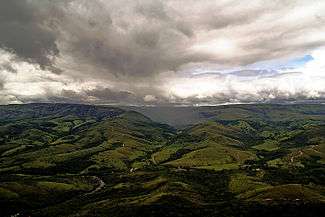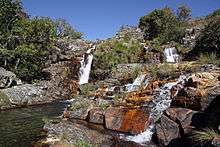Serra da Canastra National Park
Serra da Canastra National Park is in Minas Gerais, Brazil.

Created to protect the headwaters of the São Francisco river, the Serra da Canastra National Park is best known for its numerous waterfalls, diverse wildlife and for being a haven for the endangered Brazilian Merganser.
Understand
History
Named because its resemblance to a trunk (canastra, in old portuguese), the mountainous region used to be inhabited by the Cataguazes indians. Very little is known about them besides the fact that they were annihilated by the first colonial scouts in the early 17th century. By the 18th century, taking advantage of the region's remoteness, escaping slaves founded many quilombos (independent hinterland communities) alongside the mountains and many descendants of these communities still live there today. In the 1940s, there was a diamond rush in the region, but the mining activity declined and was prohibited after the creation of the park.

With an original area of 715 km² comprising the municipalities of São Roque de Minas, Vargem Bonita, Delfinópolis and Sacramento, the national park was created in 1972 aiming the preservation of the water springs surrounding the Canastra Mountains and its fauna. In 2001 a federal act extended its area to more than 2000 km² including also the Babilônia Mountains. Today, the park is managed by the Brazilian Environment Institute (IBAMA).
After the conclusion of a paved road connecting São Roque de Minas to Piumhi in 2006, there has been a rapid growth in the number of visitors, and it is now considered an important ecotourism destination in Brazil's Southeast.
Landscape
Serra da Canastra is best known for its several waterfalls, including the famous Casca D'anta waterfall. The landscape consists mainly of chapada type plateaus with bordering water springs and vast, treeless grass fields on the top.
Flora and fauna
Climate
Get in
Fees and permits
There's an entrance fee of R$16 for every individual entering the park (R$8 for Brazilian citizens). It is valid for the whole day and for all its gates. Children under 6 and adults over 60 years old are exempted of entrance fees.
Get around
See
- Stone Corral (Curral de Pedras). A corral hand-built by stacking stones, used by the tropeiros (mule-drivers) of olden days.
- Stone Garage (Garagem de Pedras). An old outpost built for those crossing the area to reach the road from São Roque de Minas to the Triângulo Mineiro.
Waterfalls

- Casca D'Anta Falls (Cachoeira Casca D'Anta), São José do Barreiro (access through Park Gate 4).
- Cerradão Falls (Cachoeira do Cerradão). 186 meters.
- Rasga Canga Falls (Cachoeira Rasga Canga).
- Rolinhos Falls (Cachoeira dos Rolinhos).
Buy
Eat
Drink
Sleep
Lodging
Camping
Backcountry
Stay safe
Go next